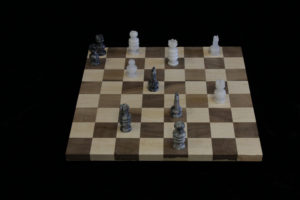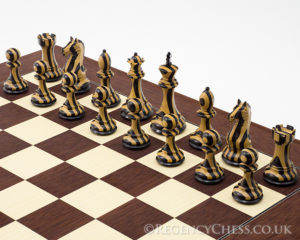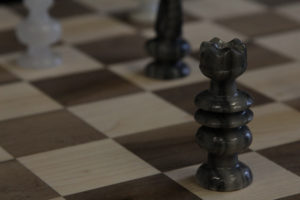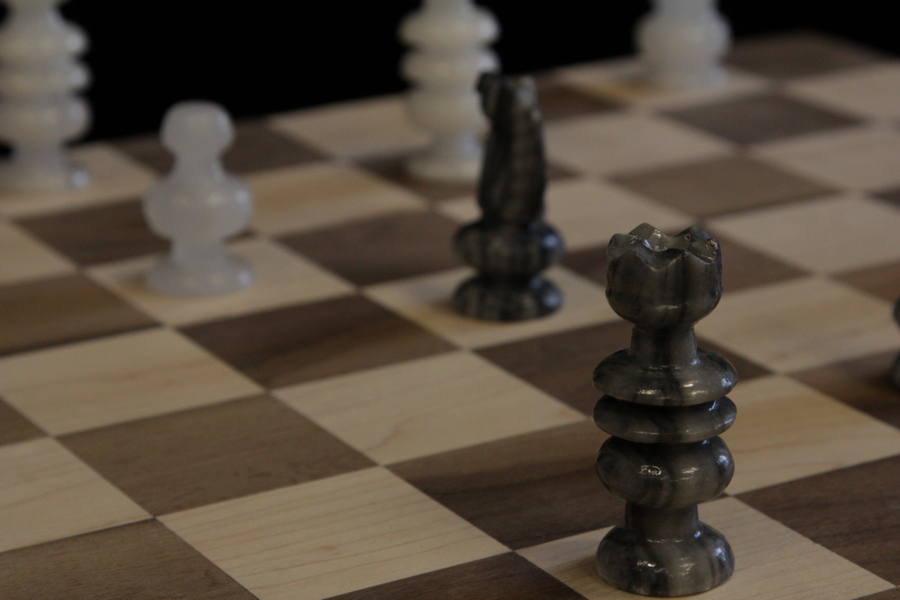Chess is the ultimate game of planning. From the very first move, one must be thinking about the next move, and your opponents’ next move. As the famous hockey player, Wayne Gretzky, once said, “ A good hockey player plays where the puck is. A great hockey player plays where the puck is going to be.” This quote certainly applies to the game of chess.
This same principal applies to chess and to engineering. For this project, I needed to plan each move precisely, calculating the time and cost, and allocating a little bit of buffer time to help lower my schedule risk. Whenever I decided to start machining or cutting wood, I took a calculated risk, just as a chess player does when he moves his queen into a risky position on the board.
Enough with the cheesy chess analogies, now time to summarize the project.
Intent Vs. Actual
From the beginning of the semester, I had an idea to create a fancy wooden chess set, something that could sit on a coffee table and act a conversation starter. Additionally, it could have function. Through my ideation and brainstorming, I thought it wood be neat to make a storage drawer under the board. However, as I discovered, woodworking can take years to master, and I certainly did not have the experience. With that said, I had worked about 60 hours in a woodshop before, so understood the basics, which would help me to create the chess board, seen below.

Due to the advanced nature of it, I did not create a storage drawer under the board. This is the next step I would like to take, but first I need to decide if it is feasible and within my budget. Using walnut and maple wood fulfills my contemporary Asian aesthetic, but ended up costing quite a bit. If I used this type of wood for the drawer, the total cost may rise to $150+. If I can find another type of wood that would work, I will consider it as my summer project.
The next step would be to put a clear protective coating on the wood to prevent unnecessary wear and preserve the colors. I do not want to make it shiny, but I want to put a clear coat on top. Something like a Polycrylic protective finish.
Additionally, I would like to acquire more chess pieces that will fit with this set. The marble ones that were used are nice, but may be a little too bland for this. Ideally, the pieces I would find would look something like this. These all have a contemporary look to them, are made of fancy, contrasting materials, and would fit the overall aesthetic. I have not decided if I want to make these pieces or purchase them.

(https://www.regencychess.co.uk/images/large/RCPB310_04_LRG.jpg)

(http://www.chess-museum.com/uploads/4/8/4/6/484601/389781_orig.jpg)
How Did the Public React?
During the symposium, I received some great reactions and feedback from viewers. Particularly, people took interest in the chess pieces, which were not built by me. People of all ages, including a 5 year old, offered to play chess. It is a timeless, classic game that most people know and love.
People also commented on the perfection of the board, and how the pieces were placed so precisely, eliminating any gaps or inconsistencies. People would run their fingers over the top to see how flush it was. I made sure this was addressed during my build process.
To help cater to this feedback I received, I would like to make my own pieces that fit my aesthetic. This could be impressive and impress people even more.
Class Impressions
Overall, I am extremely satisfied with my final product, and with what I learned this semester. I now look at items with a new view, something that I really appreciate. Instead of just seeing a chair, I now see a type of chair with a designer and story that influenced it. This approach and vision spreads to rooms, tables, buildings, cars, or any other functional items that I use on a daily basis.
Being able to engineer something that functions and operates correctly is a challenge, but building something that looks good and that people are willing to pay money for is a different story.

Photo Credit: Dr. Hertzberg


2 Comments. Leave new
Hey Ben, another Chess Quote for you. “A good chess player thinks five moves ahead. But, a great chess player thinks only one move ahead”. Chess is a universally loved game and your board looks as awesome. You could definitely make the pieces with the same dark and light woods you used to make the board. I know how hard it can be to get the surface of the board perfectly flush. You did an amazing job with that too. Great Work!
I would love to see your woodworking skills put to use once again in the finer details of designing chess pieces. I am willing to bet you could beat the challenge. However, the stone pieces have an appealing, classy look as well is this a look you would rather achieve. I can certainly vouch for the flush surface of your design. Fantastic ideation and execution!